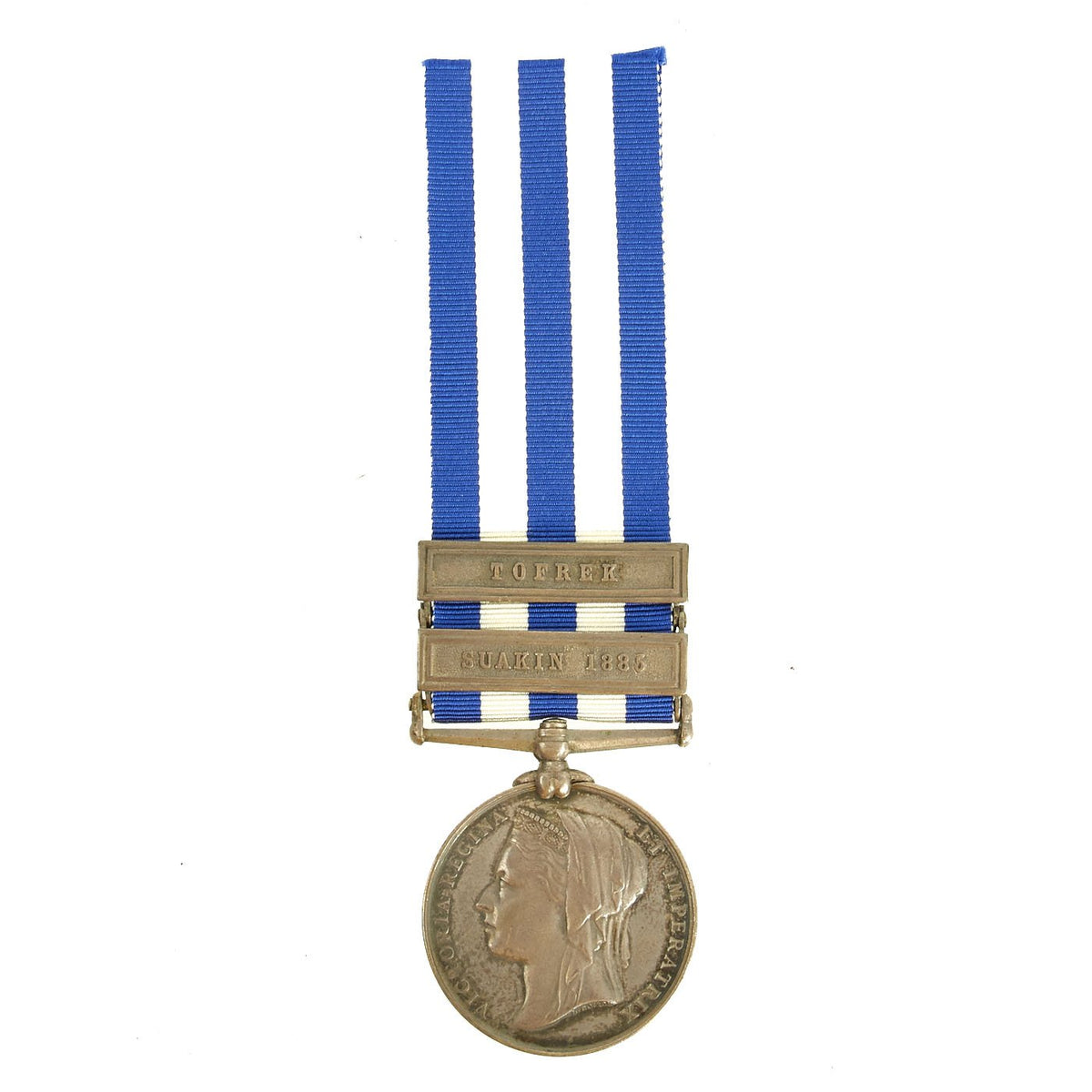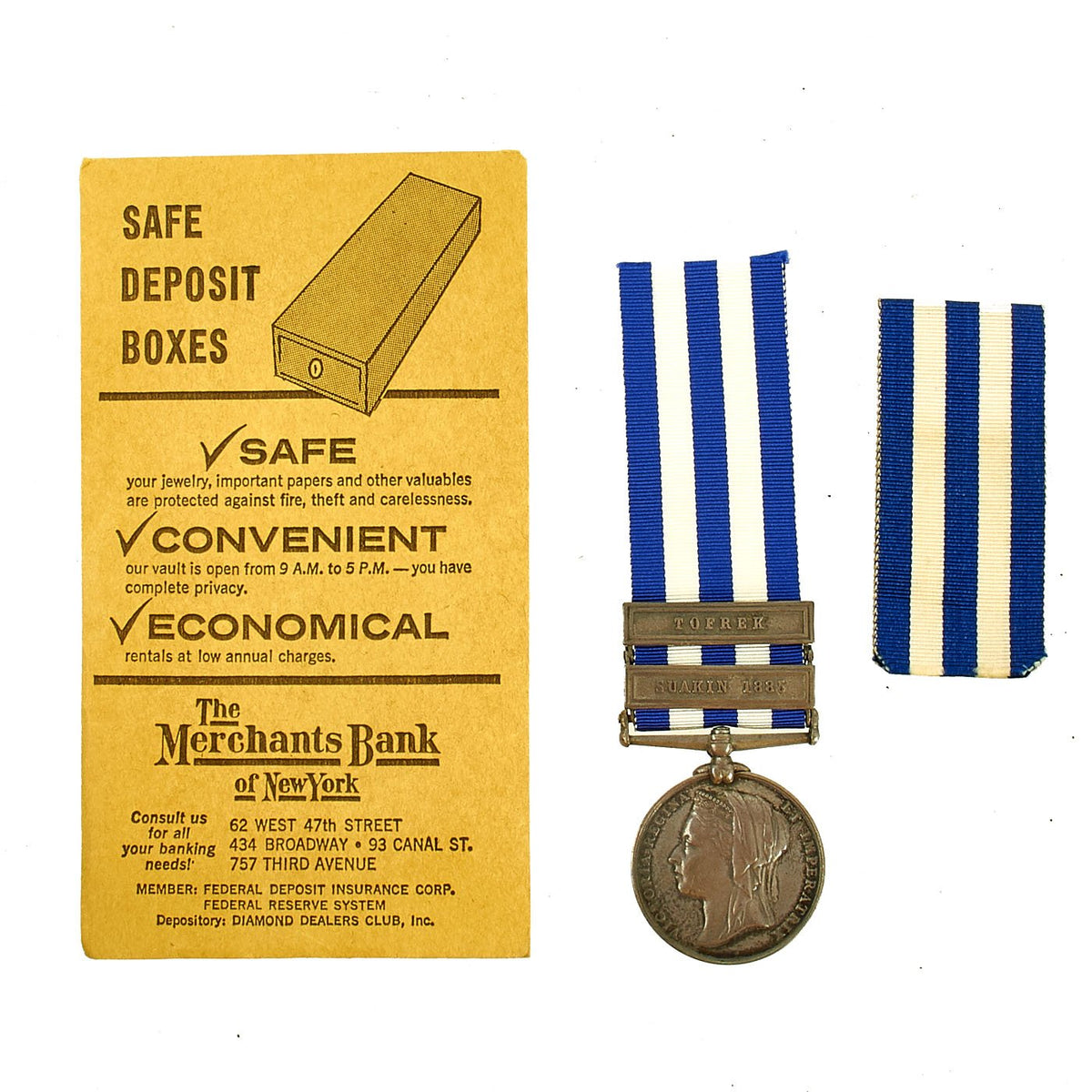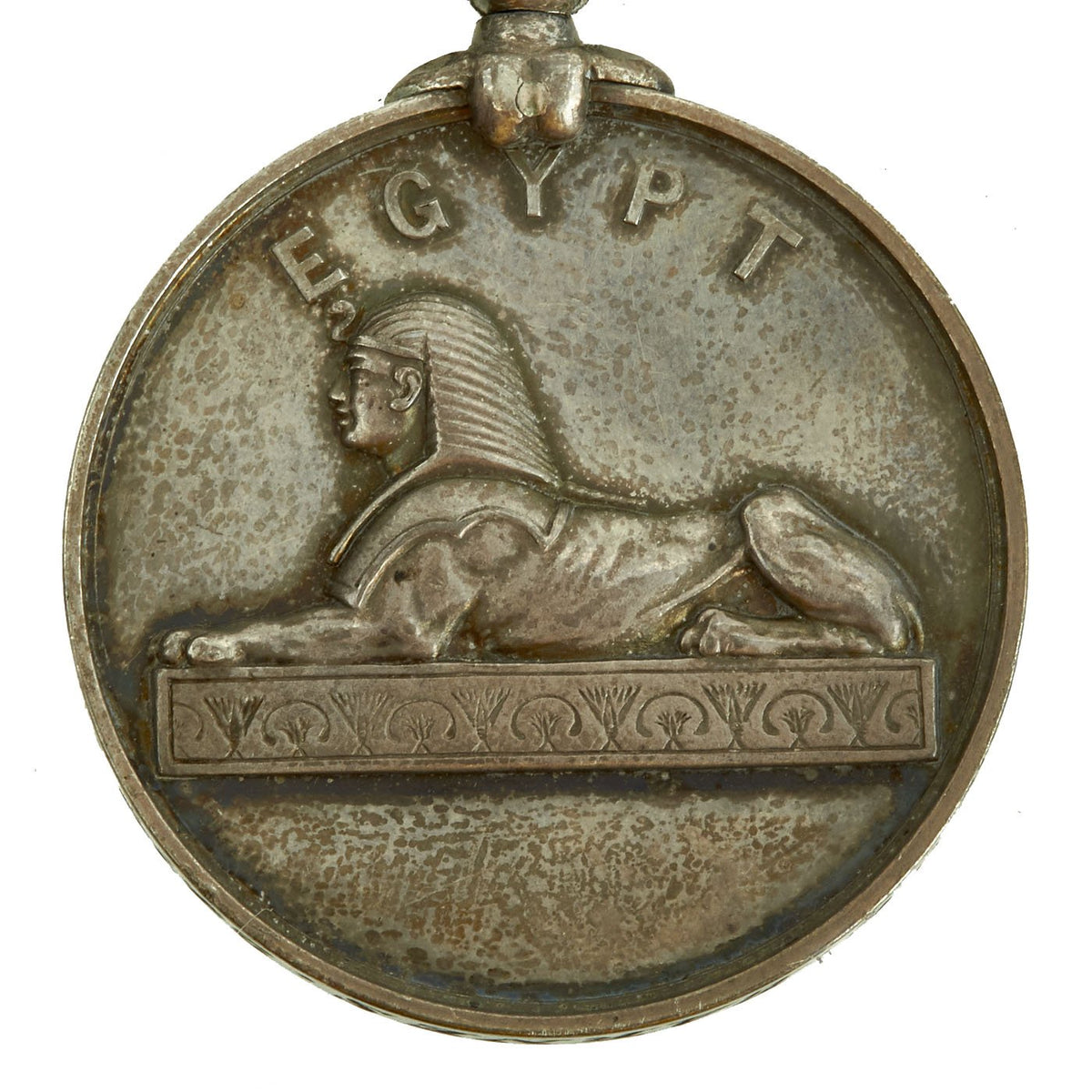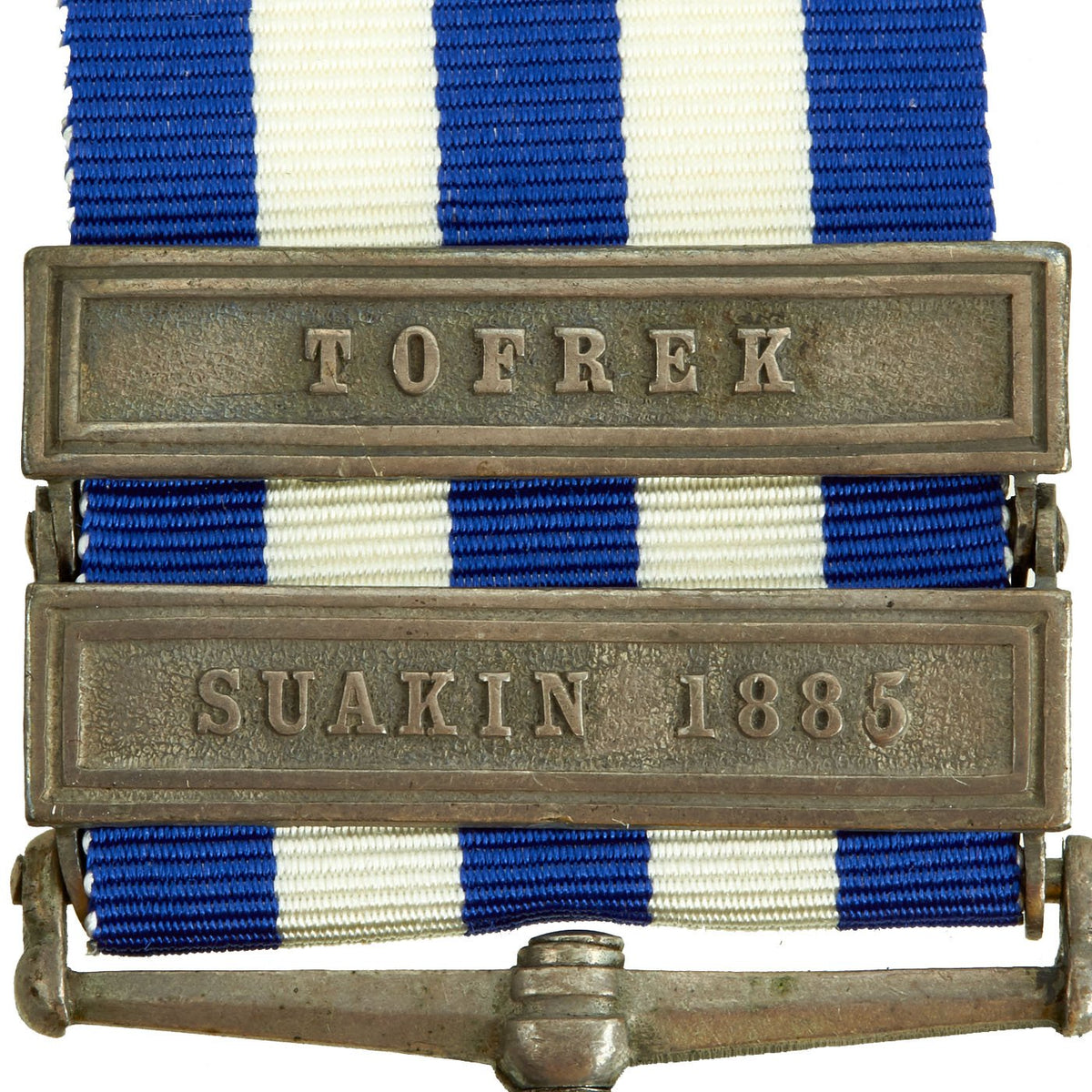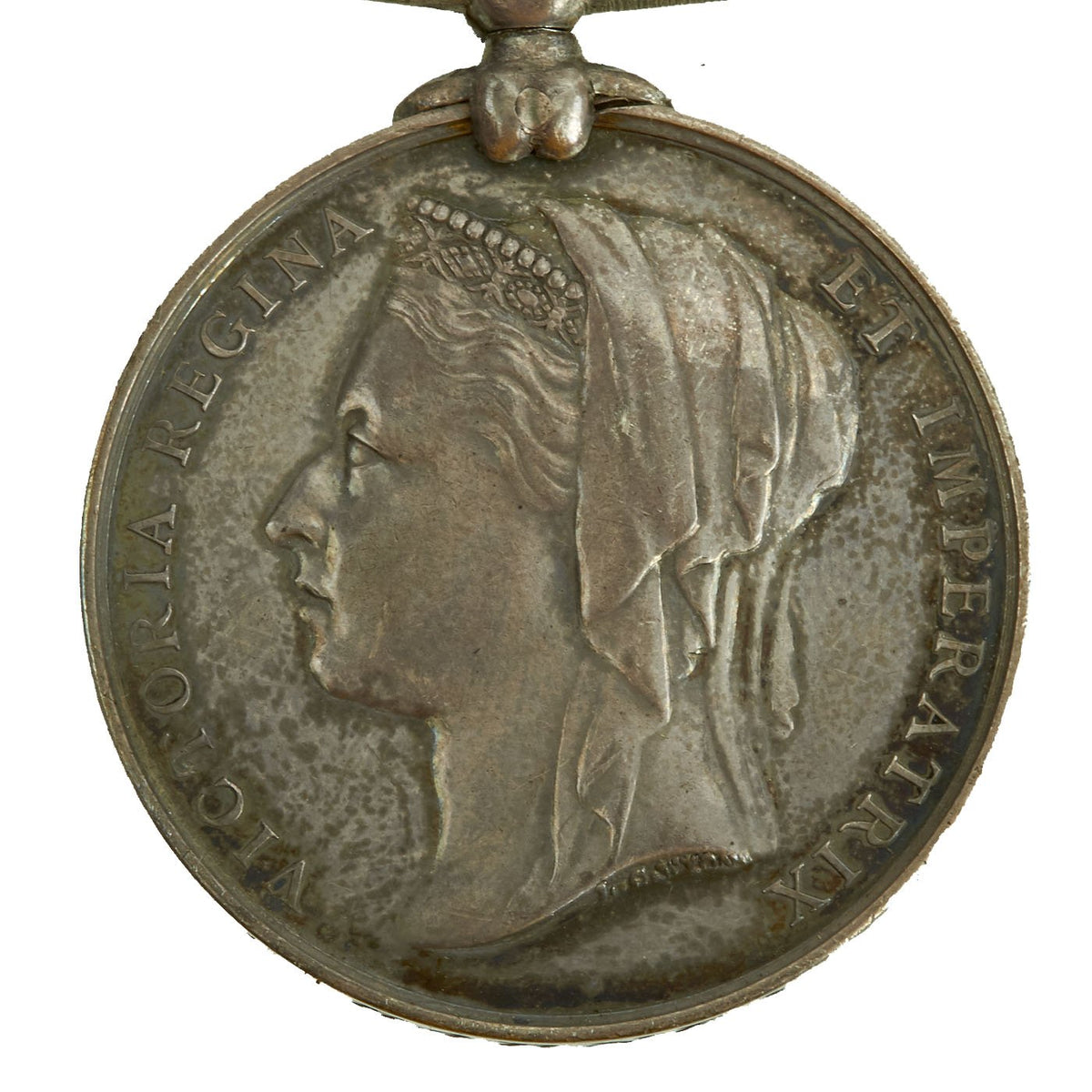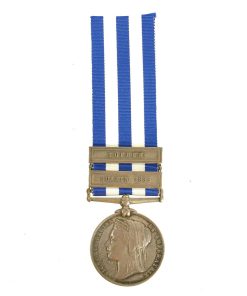Original British Mahdist Revolt Egypt and Sudan Medal 1882 – Tofrek and Saukin – 24th Company, Royal Engineers Original Items
$ 495,00 $ 148,50
Original Item: One-of-a-kind. Wonderful Egypt and Sudan Medal 1882 – 1889 with 2 Clasps – Suakin 1885 and Tofrek. Undated Reverse, engraved on the rim 15677 SAPR C. BARNES 24th Co. R.E. (Royal Engineers). Naming is official British Army impressed in large capitals (thus late issue), near very fine condition. Includes replacement ribbon.
This medal was original acquired in the early 1960s The original price in 1960 was $100 (which is marked on the safety deposit envelope). It has remained in a private collection since it was acquired in 2020.
24th Company, Royal Engineers during the The Mahdist Revolt of 1884-1885
The contributions of the Royal Engineer Field Park during 1882 the Egyptian campaign were of great value to the overall efforts of the British Corps. While enroute home to England the London Gazette of 2 November carried the notice of a mention in despatches for the Field Park’s commander, Captain C.A. Rochfort-Boyd for his actions during the campaign. He was also granted a brevet promotion to Major. All the men of the Field Park were authorized the campaign medal for Egypt.
The Field Park returned to Aldershot where George Andrews was once again employed in peacetime duties through all of 1883 and the first half of the year 1884. On the 8th of August 1884 George Andrews was posted to the 24th Company, Royal Engineers, at Shincliffe, Durham. During this period of home service for Andrews trouble had again been brewing in the Middle East. The year 1884 opened under great difficulties for the British Army of occupation in Egypt. Egypt included the Sudan, where the Egyptian government had been notorious for misrule, slave trading, and remorseless exploitation. Coincidentally, at this very period, a self-styled “Messiah” or “Mahdi” had arisen to lead a “jehad” or holy war against the Egyptians. This man, Mohamed Ahmed by name, proved the holiness of his mission with great effect, by the total massacre of over 10,000 Egyptians under the command of Colonel Hicks. The Mahdi’s chief henchman, Osman Digna, successfully initiated a campaign to imitate his master by carrying out another massacre near Suakin, of more than half of a force of about 4,000 men, under Valentine Baker. With such established prestige, every brigand in the Sudan joined the Mahdi and produced a formidable army of savage raiders, with which they established a reign of terror worse than that of the Egyptians.
The British government now felt responsible for withdrawing the Egyptian garrisons spread out around the Sudan. The most suitable man they could think of for this unenviable task was Major General Charles Gordon, Royal Engineers – a man of strong character and with a fine reputation. He had previously served Egypt as Governor-General of the Sudan. Gordon was sent out in January 1884, and a month later General Graham left Egypt with about 5,000 men to seize and hold the port of Suakin, on the Red Sea, and restore order in the area. Before the arrival of Andrews and his unit in Egypt, actions were fought against the Mahdi’s armies at El-Teb (29 February 1884), Tamaai (13 March 1884), Abu Klea (17 January 1885), and Kirbekan (10 February 1885).
On 18 February 1885 the 24th Company, commanded by Colonel E.P. Leach, VC, Royal Engineers, sailed from England bound for Suakin. Andrews and his company arrived at Suakin on the 12th of March and joined the expeditionary force under Sir Gerald Graham, to participate in the operations on The Red Sea Littoral. Within seven days after the arrival of the 24th Company, Sir Gerald’s force took to the field.
As the enemy’s detachment at Hashin threatened the right flank of any column moving south-westwards against Tamaai, Graham decided to begin operations by dispersing it and occupying both Hashin and Handub. After a reconnaissance on 19 March, he advanced against Hashin on the 20th with 10,000 men. The infantry reached some foothills near Hashin at 8.25 a.m., and the 17th and 24th Companies, R.E., and “F” Company, Madras Sappers and Miners, built four strong posts and afterwards a “zariba”. Meanwhile, the enemy retired to a steep hill in the rear, from which they were driven after a stiff fight. Leaving a garrison of infantry to guard Hashin, and a part of the 17th Field Company to improve its defences, Graham then returned to Suakin.
Having dealt with the force at Hashin, Graham turned his attention to Osman Digna’s stronghold at Tamaai. For reasons of supply it was necessary to establish intermediate posts in that direction. On March 22nd he dispatched a force under Major General Sir John McNeill, VC, KCB, towards Tamaai with orders to make and garrison two zaribas, one at five miles’ and the other at eight miles’ distance from Suakin. McNeill marched accordingly with two squadrons of cavalry, two battalions of British infantry (Berkshires and Royal Marines), three battalions of Indian infantry (15th Sikhs, 17th Bengal Native Infantry, and 28th Bombay Native Infantry), four Gardner machine-guns manned by the Royal Navy, and the 24th Field Company, R.E. under Colonel Leach. Other officers in the 24th Company included Captain E. Dickinson, and Lieutenants F.D.F. MacCarthy, C. Godby, and R.U.H. Buckland. Other units in the force included “F” Company, Madras Sappers and Miners, and the 2nd Telegraph Section, R.E. – in all, about 4,000 men. The whole force was to march to the more distant site and construct a zariba. This enclosure was then to be garrisoned by the Berkshires, Royal Marines and the 24th Field Company, while the Indian units retraced their steps to the five-mile point, where they were to build another zariba, and after leaving the 15th Sikhs to garrison it, return to Suakin.
To George Andrews the march was slow and tiresome. Open country soon gave place to mimosa bush, and the weight of his heavy pack and equipment became burdensome. Progress was necessarily slow as the troops marched in square formation for protection against any surprise attack. McNeill was aware that he might be attacked at any time. By noon, having traveled no farther than Tofrek, six miles from Suakin, he realized that he could not reach the eight-mile zariba before dusk, so he telegraphed to General Graham and received permission to make a zariba instead at Tofrek. The plan adopted for the Tofrek zariba was to form three separate squares of mimosa thorn fence, placed diagonally like squares on a chessboard – a large central square to contain transport animals, followers and stores, and two flanking squares, of smaller size, to hold the fighting troops and machineguns. Attention was devoted first to building the flanking squares under the protection of a screen of infantry pickets and cavalry vedettes in the surrounding bush. Infantry working parties proceeded to clear the bush near the zariba while the engineer units assisted them and also laid out and built the defences. To expedite the work, George Andrews and all the troops so engaged with the construction piled arms.
When the small enclosures were sufficiently advanced the Royal Marines occupied the northern flanking square with two Gardner guns, and some of the Berkshires the southern flanking square with the other two Gardners. As the bush was thickest on the north and west, the defences on these sides were finished first; but at 2 p.m., when many of the troops were at dinner, the central square was still open to the east and south and partly also to the west and north. The camels and mules, having been unloaded in the central square, were collected to the east of it, and near them were two companies of Berkshires. The 17th Bengal Native Infantry were mostly to the south of the unfinished central square, and the other two Indian battalions to the west and north of it. The heat was oppressive, the men were tired, and there was yet no proper field of fire around the incomplete defences. Hot and tired, George Andrews longed for a rest. Yet he knew, from the nature of the previous fighting against the Mahdi’s forces, that if the zariba were not properly completed on time, the dangers of a surprise attack would be great indeed. This thought spurred him on to renewed efforts to complete the defences.
At 2.30 p.m. a cavalry soldier rode into the camp. Although Andrews did not know what information he brought with him, he knew by the way that he was riding that he had an important message to deliver to General McNeill. The rider reported that the enemy were advancing upon the zaribas, and orders were given for the working and covering parties to come in. Andrews looked to where his rifle was piled but before he could move any distance towards it the cavalry outposts came galloping in towards the zariba with the Sudanese swarming at their heels. Andrews knew then that without the means to defend himself, he chances of survival were slim to none.
The attack was delivered mainly on the southern and eastern sides and into the midst of the transport animals and noncombatants. Enveloped in clouds of dust, and filling the air with savage cries, the Sudanese surged onwards in a vast impetuous mass. His mouth dry from the heat, dust, and fear, George Andrews rushed for his rifle. He and some others of his working party found their weapons in time; others did not.
Thrown into disorder by the cavalry riding through them, the 17th Bengal Native Infantry fired a volley, broke their ranks, and rushed towards the central square. Two companies of the Berkshires, forming square to the north of the transport animals, stood firm, but the enemy were soon among the camels and mules, and an avalanche of Sudanese, Bengal Infantry, followers and animals burst through the central square in a stabbing and hacking mob and carried many of the Royal Engineers and Madras Sappers with them. A party of the 24th Field Company, under Lieutenant F.D.F. MacCarthy, R.E., swept away like straws in a wind, managed to fight their way back and rejoined their comrades. Another party, under Lieutenant C. Godby, R.E. joined the rallying square of the Berkshires outside the zariba and helped to repel the assault. George Andrews stood his ground. With his Martini-Henry rifle in hand, bayonet fixed, he fought for his life. For the next few minutes he was an infantryman, pure and simple. Targets were plentiful; range three to five yards. His marksmanship at this point was not as important as his ability to load his single action rifle as fast as he could and fire it point blank into the body of a closing Sudanese. At that range, the large .45 caliber bullet of the Martini tore large, gaping holes in the bodies of his opponents. The force of the impact of the bullets was enough to bodily lift his target off his feet and carry him backwards. Between rounds Andrews used his bayonet to dispose of any nearby opponent. Loading, firing, thrusting, parrying, reloading and firing again; George Andrews fought for his life. Covered with blood and dust, he had very little time to observe the other members of his unit fighting beside him. He saw Sapper J. Fletcher of his company die under the hacking swords and stabbing spears of the Sudanese. He saw 15498 Driver Thomas Redwood of the Telegraph Section, R.E. dispatch a number of Sudanese with his rifle and bayonet. He had served with Redwood in South Africa and in Egypt three years before. Tom seemed to be doing well for himself, and Andrews hoped he would make it through the fight. He had his own problems to deal with however, so the thoughts of his friend quickly passed from his mind.
When the attack began, Captain F.J. Romilly, R.E., was superintending the Madras Sappers who were loading their equipment on mules. The retreating Bengal Infantry carried these Sappers with them across the unfinished angle of the central square. Andrews caught a glimpse of Captain Romilly, mounted on his horse, riding through the mob of Indian troops and Sudanese. As he watched, a Sudanese ran alongside Romilly’s horse and speared the Captain in the side piercing his heart. The Sudanese was immediately shot. Romilly had been attempting to save the life of a brother officer. Andrews also saw Captain C.B. Wilkieson, R.E. go down with a severe wound in the leg, and watched Lieutenant E.M.B. Newman, R.E. killed by a swordsman. Newman was attacked by a Sudanese carrying a murderous sword, five feet in length, with razor sharp edges. With two strokes the Sudanese severed Newman’s left arm and sliced the top of his head clean off. His killer was soon among the dead himself.
The situation at Tofrek that day was saved chiefly by the Royal Marines and those of the Berkshires who were securely entrenched with their Gardner guns in the flanking squares, although their fire killed hundreds of their own stampeding camels. Both the 24th Field Company, R.E. and “F” Company, Madras Sappers and Miners, suffered severely. George Andrews was one of the fortunate ones.
The battle at Tofrek on 22nd March 1885 was finished in 20 minutes, a brief period crowded with instances of cool bravery, wild bewilderment, and fanatical desperation. When the smoke cleared away the place was a shambles. As Andrews leaned on his rifle, utterly exhausted, he saw the dead bodies of men and animals laying in heaps on every side of him. The British losses amounted to about 100 men killed and 140 wounded, and no less than 900 camels lay dead on the field. At least 1,000 Sudanese lay motionless around and within the zariba. The Sudanese fought, as usual, with extraordinary courage. Braving the British rifle fire, charging on to the points of their bayonets, hurling themselves into or over the thorny defences, they showed an absolute disregard for death. The action at McNeill’s zariba, as it is sometimes called, was a bloody affair, but it had good results for the British. The Sudanese began to lose confidence in Osman Digna, who had told them that the British bullets were made of water and could do them no harm. News of the battle was telegraphed to Suakin, and Graham rode out on the 23rd at the head of a strong force that safeguarded the position.
After a short rest the 24th Field Company began clearing the battlefield and rebuilding the zariba on a smaller scale to suit a garrison of one battalion. Water was scarce and the heat was terrific. Andrews and the other men of the company suffered considerably from the hot work. Men of the unit collapsed in dozens from sunstroke. On 2 April General Graham marched with a strong force from Suakin to attack Osman Digna at Tamaai, taking with him the 17th Field Company, and picking up the 24th Field Company and the other troops at Tofrek, so that he was able to continue with 8,000 fighting men and 4,000 animals. Before dusk he halted, and his engineer troops searched for water and assisted the infantry in making a second zariba. On the 3rd he advanced again towards the villages at Tamaai which had long been Osman Digna’s headquarters. It soon became evident that there would be no resistance, and the force proceeded through the villages, which were found to be deserted. The wells in the villages were almost dry. This failure of the water supply may have been the cause for Osman Digna’s departure, but it also precluded any further advance by Graham. He destroyed the enemy’s huts and stores and retraced his steps to Suakin, arriving there on the 4th April. Offensive operations were now practically at an end. Most of the tribes had deserted Osman Digna, and the elusive Sudanese leader was believed to be well on his way to Sinkat. It was safe to devote particular attention to pushing construction of the Suakin-Berber railway, so the garrison of Tofrek was withdrawn, and Handub, ten miles west of Suakin, was occupied without opposition on 8th April. The 24th Field Company set about constructing a portion of the embankment for the Suakin-Berber railway line at Handub, along with a railway blockhouse.
On the 16th April General Graham’s force advanced to occupy Otao. On the l9th the advance continued to occupy Tambuk. The 24th Field Company was given the task of developing the water supply for each post at Handub, Otao, and Tambuk. George Andrews was involved with this work until 17th May when General Graham withdrew his entire force to Suakin. Most of the units of Graham’s force departed the Sudan shortly after their return to Suakin. Only a small garrison, including George Andrews and the rest of the 24th Field Company, remained in the city. Finally, on 17th of July Andrews was ordered to leave the 24th Field Company and returned to England.
Fast Shipping with Professional Packaging
Thanks to our longstanding association with UPS FedEx DHL, and other major international carriers, we are able to provide a range of shipping options. Our warehouse staff is expertly trained and will wrap your products according to our exact and precise specifications. Prior to shipping, your goods will be thoroughly examined and securely secured. We ship to thousands clients each day across multiple countries. This shows how we're dedicated to be the largest retailer on the internet. Warehouses and distribution centres can be located throughout Europe as well as the USA.
Note: Orders with more than one item will be assigned a processing date depending on the item.
Before shipping before shipping, we'll conduct a thorough inspection of the items you have ordered. Today, the majority of orders will be delivered within 48 hours. The delivery time will be between 3-7 days.
Returns
The stock is dynamic and we cannot completely manage it because multiple stakeholders are involved, including our factory and warehouse. So the actual stock may alter at any time. It's possible that you may not receive your order once the order has been made.
Our policy is valid for a period of 30 days. If you don't receive the product within 30 days, we are not able to issue a refund or an exchange.
You can only return an item if it is unused and in the same state as the day you received it. You must have the item in its original packaging.
Related products
Uncategorized
Band of Brothers ORIGINAL GERMAN WWII Le. F.H. 18 10.5cm ARTILLERY PIECE Original Items
Uncategorized
Uncategorized
Uncategorized
Uncategorized
Uncategorized
Uncategorized
Angolan Rebel 1970s era 60mm Inert Display Mortar from Angolan Civil War Original Items
Uncategorized
Uncategorized
Uncategorized
Uncategorized
Australian WWII Owen MK1 Machine Carbine SMG Custom Fabricated Replica with Sling Original Items
Uncategorized
Uncategorized
Uncategorized
Uncategorized
Uncategorized
Uncategorized
